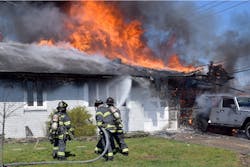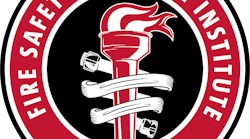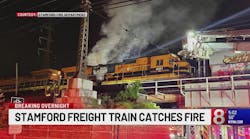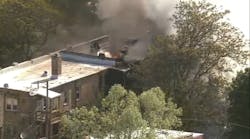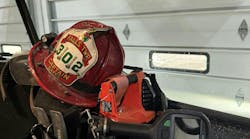Smoke showing. Years ago, it meant just that, and a smoke explosion at a dwelling was rather rare. However, these days, it isn’t uncommon to search the internet and find several smoke explosions per day from all over North America and beyond.
Causes of a smoke explosion in dwellings today compared with in the past include much more highly combustible contents and much more insulation.
Also, years ago, many fires weren’t discovered until they were blowing out windows. Today, there is quicker notification of the fire department, what with alarm systems and the preponderance of cellphones (no looking for a fire alarm box or a nearby phone).
We would like to express our sincere thanks to the officers and members of the Wantagh, NY, Fire Department (WFD), including Assistant Chief Leonard Mathewson, PIO Kevin J. Regan, Chief of Department Thomas Bloomfield and past Chief John Loeber, for their assistance in providing this information. Additionally, thanks to Daniel Madrzykowski, who is the director of research for UL’s Fire Safety Research Institute (FSRI), for his thoughts on this incident.
Smoke showing and then …
At approximately 2:15 p.m. on Sunday, April 9, 2023, WFD Dispatcher Lauren Fortuna received a call
reporting a house fire in Levittown. As units responded, she received additional calls. Fortuna alerted Mathewson, who was responding to the incident. This prompted him to ask for a general alarm from dispatch, which alerted all WFD stations to respond.
The on-duty safety officer, former Capt. Nick Finocchio, was first to arrive, and he reported a heavy volume of fire visible at the front of the house, with heavy smoke conditions as well. Mathewson arrived moments later and requested that a working fire dispatch be transmitted. Flames were extending out of the garage on the A/D corner of the dwelling.
The owners of the house weren’t home, and the house was unoccupied.
Engine 2 was the first engine on scene, and the crew hooked up to a hydrant that was in front of the house.
An automobile that was parked on the driveway and the garage were on fire. After knocking down that fire, a crew that was led by Capt. Mike Fratello, along with Second Assistant Chief Bill Stevens, who was to be in charge of interior operations, advanced a hoseline through the front door. They were in the process of attacking the fire when an explosion occurred.Firefighters were fortunate to quickly get out, although two members sustained non-life-threatening injuries.
Because of the rapidly deteriorating conditions and concern of further violent fire conditions within the house, Mathewson ordered all firefighters out of the structure and a personnel accountability to ensure that all members were accounted for, while commencing an exterior attack.
A deck gun from Engine 2, a master stream from Ladder 1 and several WFD handlines were deployed as well as an additional master stream from Bethpage Fire Department (BFD) Ladder 3.
The fire was declared under control in approximately 75 minutes. The structural integrity of the house had to be ensured before firefighters could re-enter the premises to extinguish pockets of fire that were in the basement that weren’t accessible from the exterior.
A complex incident
Firefighters faced numerous challenges, including a violent event shortly after they entered the house. It forced them to withdraw from an interior attack; multiple members required medical attention. There also were water supply issues.
Fortunately, the training that the members do on a daily and weekly basis resulted in all of these challenges being met without further injury or escalation.
Medics from the Nassau County Police Emergency Ambulance Bureau treated and transported one of the two injured members to Nassau University Medical Center (NUMC) Burn Center. The second member was treated and transported to NUMC by a Levittown Fire Department (LFD) crew. Both members were treated and released a short time later.In total, five engines, two truck companies, one squad and one ambulance of the WFD responded in addition to the EMS captain, rehab unit and fire-police. Because of the complexity of the incident and potential for further expansion, additional staffing and equipment were requested to respond to the scene or to stand by in WFD Station #2 to provide coverage for any additional alarms.
The BFD, LFD, Bellmore Fire Department, East Meadow Fire Department, Massapequa Fire Department, North Bellmore Volunteer Fire Department, North Massapequa Fire Department and Seaford Fire Department provided assistance to the scene or coverage.
During the duration of the incident, two additional alarms were handled by stand-by units. Command was terminated nearly three hours after the alarm was transmitted.
Observations from Goldfeder
The WFD arrived within minutes of the dispatch. Heavy smoke was pushing from the eaves and some of the windows, and there was fire in the A/D corner, with a vehicle as an exposure. The first-due members hit the fire on the corner and then worked their way into the Alpha side main door entrance. When interviewed, they told us that when they went inside, the conditions were cool, with good visibility and no heavy heat. Suddenly, there was a smoke explosion, with smoke/fire “blowing” out and landing the members onto the front yard of the house.
Video of the fire clearly shows the smoke pushing, some fire very briefly emerging from the eaves and, moments later, the smoke explosion occurring.
Essentially, the fire started in the basement of the dwelling, worked its way up and out (A/D side) and then traveled up into the attic area, building from there.
In discussions with the WFD chiefs and FSRI’s Madrzykowski, it was agreed that if the WFD were to have “this” fire again, after the hit on the A/D corner, water would be kept flowing into the eaves. Members would gain front access, pull small sections of the ceilings upon entry, and continue to flow up and above into the attic space. It’s important to cool the wood roof underlayment in the attic, because the pyrolyzing wood generates fuel, heat and pressure in the attic.
